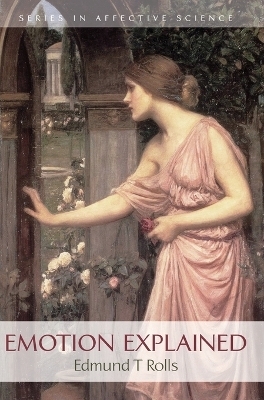
Emotion Explained
Oxford University Press (Verlag)
978-0-19-857003-5 (ISBN)
What produces emotions? Why do we have emotions? How do we have emotions? Why do emotional states feel like something? This book seeks explanations of emotion by considering these questions.
Emotion continues to be a topic of enormous scientific interest. This new book, a successor to 'The Brain and Emotion', (OUP, 1998), describes the nature, functions, and brain mechanisms that underlie both emotion and motivation. 'Emotion Explained' goes beyond examining brain mechanisms of emotion, by proposing a theory of what emotions are, and an evolutionary, Darwinian, theory of the adaptive value of emotion. It also shows that there is a clear relationship between motivation and emotion. The book also examines how cognitive states can modulate emotions, and in turn, how emotions can influence cognitive states. It considers the role of sexual selection in the evolution of affective behaviour. It also examines emotion and decision making, with links to the burgeoning field of neuroeconomics. The book is also unique in considering emotion at several levels - the neurophysiological, neuroimaging, neuropsychological, behavioural, and computational neuroscience levels.
Edmund T. Rolls is Professor of Experimental Psychology at the University of Oxford, and a Fellow and Tutor of Corpus Christi College, Oxford. He read preclinical medicine at the University of Cambridge, and now performs research in neuroscience at Oxford. His research links neurophysiological and computational neuroscience approaches to human functional neuroimaging and neuropsychological studies in order to provide a fundamental basis for understanding human brain function and its disorders. He is author of The Brain and Emotion (1999, Oxford University Press), with A.Treves of Neural Networks and Brain Function (1998, Oxford University Press), and with G.Deco of Computational Neuroscience of Vision (2002, Oxford University Press).
1. Introduction: the issues ; 1.1 Introduction ; 1.2 Rewards and punishers ; 1.3 Approaches to emotion and motivation ; 1.4 Outline ; 2. The nature of emotion ; 2.1 Introduction ; 2.2 A theory of emotion ; 2.3 Different emotions ; 2.4 Refinements of the theory of emotion ; 2.5 The classification of emotion ; 2.6 Other theories of emotion ; 2.7 Individual differences in emotion, personality and emotional intelligence ; 2.8 Cognition and emotion ; 2.9 Emotion, motivation, reward and mood ; 2.10 The concept of emotion ; 2.11 Advantages of the approach ; 3. The functions of emotion: reward, punishment and emotion in brain design ; 3.1 Introduction ; 3.2 Brain design and the functions of emotion ; 3.3 Selection of behaviour: cost-benefit 'analysis' ; 3.4 Further functions of emotion ; 3.5 The functions of emotion in an evolutionary, Darwinian, context ; 3.6 The functions of motivation in an evolutionary, Darwinian, context ; 3.7 Are all goals for action gene-specified? ; 4. The brain mechanisms underlying emotion ; 4.1 Introduction ; 4.2 Overview ; 4.3 Representations of primary reinforcers ; 4.4 Representing potential secondary reinforcers ; 4.5 The orbitofrontal cortex ; 4.6 The amygdala ; 4.7 The cingulate cortex ; 4.8 Human brain imaging investigations of mood and depression ; 4.9 Output pathways for emotional responses ; 4.10 Effects of emotion on cognitive processing and memory ; 4.11 Laterality effects in human emotional processing ; 4.12 Summary ; 5. Hunger ; 5.1 Introduction ; 5.2 Peripheral signals for hunger and satiety ; 5.3 The control signals for hunger and satiety ; 5.4 The brain control of eating and reward ; 5.5 Obesity, bulimia and anorexia ; 5.6 Conclusions on reward, affective responses to food, and the control of appetite ; 6. Thirst ; 6.1 Introduction ; 6.2 Cellular stimuli for drinking ; 6.3 Extracellular thirst stimuli ; 6.4 Control of normal drinking ; 6.5 Reward and satiety signals for drinking ; 6.6 Summary ; 7. Brain-stimulation reward ; 7.1 Introduction ; 7.2 The nature of the reward produced ; 7.3 The location of brain-stimulation reward sites in the brain ; 7.4 The effects of brain lesions on intracranial self-stimulation ; 7.5 The neurophysiology of reward ; 7.6 Some of the properties of brain-stimulation reward ; 7.7 Stimulus-bound motivational behaviour ; 7.8 Conclusions ; 7.9 Apostasis ; 8. Pharmacology of emotion, reward and addiction; the basal ganglia ; 8.1 Introduction ; 8.2 The noradrenergic hypothesis ; 8.3 Dopamine and reward ; 8.4 The basal ganglia ; 8.5 Opiate reward systems, analgesia, and food reward ; 8.6 Pharmacology of depression in relation to brain systems involved in emotion ; 8.7 Pharmacology of anxiety in relation to brain systems involved in emotion ; 8.8 Cannabinoids ; 8.9 Overview of behavioural selection and output systems involved in emotion ; 9. Sexual behaviour, reward and brain function; sexual selection of behaviour ; 9.1 Introduction ; 9.2 Mate selection, attractiveness and love ; 9.3 Parental attachment, care and parent-offspring conflict ; 9.4 Sperm competition ; 9.5 Concealed ovulation and its consequences for sexual behaviour ; 9.6 Sexual selection of sexual and non-sexual behaviour ; 9.7 Individual differences in sexual rewards ; 9.8 The neural reward mechanisms that might mediate some aspects of sexual behaviour ; 9.9 Neural basis of sexual behaviour ; 9.10 Conclusion ; 10. Emotional feelings and consciousness: a theory of consciousness ; 10.1 Introduction ; 10.2 A theory of consciousness ; 10.3 Dual routes to action ; 10.4 Representations ; 10.5 Discussion ; 10.6 Conclusions and comparisons ; 11. Conclusions and broader issues ; 11.1 Conclusions ; 11.2 Decision-making ; 11.3 Emotion and ethics ; 11.4 Emotion and literature ; 11.5 Close ; App A Neural networks and emotion-related learning ; App B Reward reversal in the orbitofrontal cortex - a model
| Erscheint lt. Verlag | 8.9.2005 |
|---|---|
| Reihe/Serie | Series in Affective Science |
| Zusatzinfo | 16 pp colour plates, numerous halftones and line drawings |
| Verlagsort | Oxford |
| Sprache | englisch |
| Maße | 174 x 248 mm |
| Gewicht | 1371 g |
| Themenwelt | Geisteswissenschaften ► Psychologie ► Allgemeine Psychologie |
| Geisteswissenschaften ► Psychologie ► Persönlichkeitsstörungen | |
| Geisteswissenschaften ► Psychologie ► Test in der Psychologie | |
| Geisteswissenschaften ► Psychologie ► Verhaltenstherapie | |
| Naturwissenschaften ► Biologie ► Zoologie | |
| ISBN-10 | 0-19-857003-1 / 0198570031 |
| ISBN-13 | 978-0-19-857003-5 / 9780198570035 |
| Zustand | Neuware |
| Haben Sie eine Frage zum Produkt? |
aus dem Bereich


